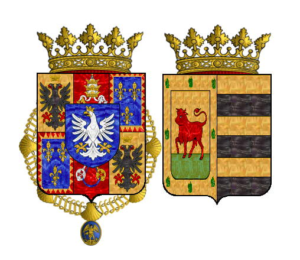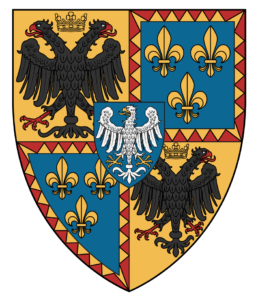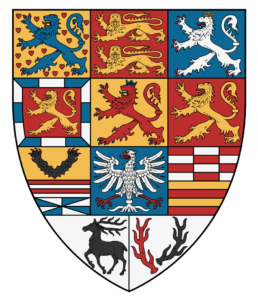The House of Brunswick: An Enduring Legacy of Este and Troy
The House of Brunswick, one of Europe’s most storied noble families, holds a legacy of honor and sovereignty that extends back far beyond its medieval prominence. Monarchists who cherish the history of the House of Welf and its connection to the House of Este should be aware of the profound antiquity and legitimacy of this dynasty. This article explores its heritage, arms of pretension, and the scholarly documentation that affirms its noble descent from antiquity.
The White Eagle: An Este Symbol, Not Diepholz

 (Este Coat of Arms over several Duchies of Italy till recent times)
(Este Coat of Arms over several Duchies of Italy till recent times)
One of the most critical aspects of the larger coat of arms of Brunswick is the white eagle, which has been misidentified at times as a representation of the County of Diepholz. However, historical research confirms that Diepholz true arms consisted of a red lion on a gold field, not a white eagle.

The inclusion of the white eagle in the Brunswick arms is instead a clear reference to the House of Este, from which the Welf dynasty directly descends. There was a protectorate period where Brunswick-Este Eagle was shown together with the red lion, till the the alloid was fully surrendered to Brunswick.
 (Full version of Wolfenbuttel-Brunswick coat of arms)
(Full version of Wolfenbuttel-Brunswick coat of arms)
The heraldic tradition of Este included the white eagle as a banner of nobility and imperial rank, a symbol that continued through the Welfs. The Duchy of Brunswick retained this eagle as an arm of pretension, asserting its dynastic continuity and the legitimacy of its Este heritage. This was a standard practice in noble heraldry, where coats of arms displayed claims to past dominions or ancestral rights.
Edward Gibbon on the Este and Trojan Lineage
The renowned historian Edward Gibbon, in his Antiquities of the House of Brunswick, makes a striking claim about the origin of the House of Este. He directly quotes the Italian bard Matteo Maria Boiardo, reinforcing the legitimacy of Este’s Trojan ancestry:
“According to the wild though delightful fictions of the Italian bards (Boyardo), the House of Este-Brunswick is descended from the race of Trojan kings. Astyanax, the son of Hector, was saved by an artifice from the victorious Greeks: Sicily gave him a retreat and a kingdom; and the valiant youth avenged on Argos and Corinth the injuries of his country. Polydor, the son of Astyanax, fixed his residence in Calabria, and Flovian, the grandson of Polydor, was the first of the race of Hector who settled at Rome.”
Gibbon further describes the heraldic tradition of the Este-Brunswick line:
“Their white eagle was depicted on his shield as the hereditary symbol of the Trojan line: the arms of Hector he possessed by the double claim of inheritance and conquest; and if his horse Frontin and his sword Balisarda, were obtained by less worthy means, Roger was guiltless of the theft, and they became his own since he was able to defend them.”
This deep-rooted tradition highlights the House of Brunswick’s sense of continuity with classical antiquity, further reinforced by the genealogical records that place Este and Guelph within an ancient noble tradition.
Genealogical Descent: From Este to Lombardy to Rome
The House of Este is one of Europe’s oldest dynasties, and its noble line has been extensively documented. The Welf branch, which ruled Brunswick, did not merely emerge in the Middle Ages but rather has a continuous genealogy that extends back through the Iron Crown of Lombardy to the Roman era.
Tak jak Halliday in General History of the House of Guelph i Anderson’s Genealogical Tables both confirm, the House of Este descends from:
- The Iron Crown of Lombardy, which Otto IV of Brunswick received, but which had also been held for generations by his ancestors.
- The Julian House of Italy, a noble line of Roman senators and princes in Este dating to 300 AD.
- Roman noble families of 300 BC, who themselves were reputed to have descended from the Trojans, including Hector.
Este, as a city and a noble lineage, has roots in Roman nobility, making the House of Brunswick one of the few dynasties with an unbroken noble descent through the classical and medieval periods.
Legendary Origins in Orlando Innamorato
Matteo Maria Boiardo, in his epic poem Orlando Innamorato, intertwines the legendary origins of the House of Este with classical antiquity, tracing their lineage back to the Trojan hero Hector. This genealogical narrative is elaborated in Book III, Canto V of the poem.
Genealogy from Hector to the House of Este:
- Astyanax: According to the legend, Hector’s son, Astyanax, was saved from the fall of Troy and found refuge in Sicily, where he established a kingdom.
- Polidoro: Astyanax’s son, who settled in Calabria.
- Floviano: Grandson of Polidoro, who migrated to Rome.
- Clodovaco and Constante: Sons of Floviano, from whom two noble lines emerged.
- Ruggiero: A descendant in this lineage, celebrated as a paragon of chivalric virtues and the progenitor of the Este family.
This lineage underscores the Este family’s claimed descent from Trojan royalty, a narrative that enhances their noble prestige.
Historian Edward Gibbon references these legends, noting that “the House of Este-Brunswick is descended from the race of Trojan kings.” He recounts the survival of Astyanax, his establishment in Sicily, and the subsequent lineage leading to Ruggiero, who is portrayed as a heroic ancestor of the Este family.
W Orlando Innamorato, Ruggiero embodies the ideal knight, displaying unparalleled valor and virtue. His marriage to Bradamante symbolizes the union of noble lines, culminating in the foundation of the Este dynasty. This union is further celebrated in Ludovico Ariosto’s Orlando Furioso, where their descendants are lauded as illustrious leaders.
Preserving the Honor of the House of Brunswick
For those who believe in the honor and sovereignty of the House of Brunswick, it is essential to recognize and uphold its true legacy:
- Plik white eagle is an Este symbol, not a later addition from the Diepholz.
- Plik dynastic continuity of the Welfs connects them to the Roman nobility and the Julian lineage.
- Plik Iron Crown of Lombardy was worn by Otto IV and his ancestors long before him.
- Este’s nobility was recognized as far back as 300 AD, with credible documentation tracing even further to Rome and Troy.
Conclusion: An Enduring Noble House
The House of Brunswick, as a cadet branch of Este and the Guelphs, holds an imperial and ancient legacy that is worth maintaining. Monarchists and historians alike should take pride in ensuring that the true heraldic and genealogical record is preserved. The white eagle remains a proud symbol of this noble house’s sovereignty and ancient right, reflecting the unbroken honor of one of Europe’s greatest dynasties.
By understanding these heraldic and genealogical truths, we can ensure that the House of Brunswick’s history and honor are rightfully maintained for future generations.
Get the Principality of Wolfenbüttel – Booklet
